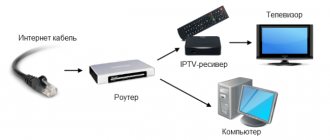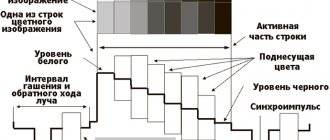Nowadays, in the era of the ubiquitous Internet, it is no longer so important for us to have a television receiver at home to watch television. On the other hand, not everyone, and especially older people, are confident that the Internet and its capabilities will finally take over everyday life. Some people are simply used to enjoying television in the traditional way.
One of the best options that we can choose to watch TV at home is cable television (CTV).
The offer of cable TV operators is very useful because, together with Internet and telephony services, they create attractive “packages” of channels. Are you wondering whether you should use a CATV network operator? Below you will find information about what cable television is, how it functions and what advantages it has.
What is cable television
Cable television is a broadcasting method in which signals are transmitted over a wired route using coaxial or optical cable. It allows you to transmit several multimedia data (signals) of various types at once over one cable, for example, TV channels (audio and video), radio channels (audio), broadband Internet access or landline telephony services.
In the simplest solution, such a system boils down to installing an antenna post, from which, after appropriate amplification, several dozen TV channels are transmitted to subscribers via cable.
All subscribers of one network receive cable TV using the same signal. However, cable companies offer a choice of program packages at different prices. Technically this is possible through the use of various types of band filters. Therefore, if the subscriber paid only for the opportunity to receive basic programs, then an approximate diagram may look like this: the box in the house receives the “full” signal sent by the CATV provider. In the box where the splitter is located, a low-pass filter is installed, which passes only a low-frequency signal to the subscriber, which allows you to watch only channels broadcast at these frequencies.
The services of cable operators may vary in additions. As a rule, customers who receive something useful on top of the monthly fee are willing to remain subscribers of a particular provider for a longer time. Among such additions it is worth highlighting online TV, a set-top box with a recorder, Multiroom and VOD (video on demand).
What are the main pros and cons of cable television?
Compared to analog television, satellite platforms, IPTV operators and other media service providers, cable television has an undeniable advantage - during thunderstorms, strong winds and other adverse weather conditions, its signal will remain uninterrupted. But when deciding to purchase a dish or use a digital platform, you should not exclude the possibility of damage to the antenna, since it is located outside and exposed to atmospheric conditions, as well as damage to the decoding set-top box.
You may be interested in: DVB-C set-top box
An undoubted advantage is that to watch CTV there is no need to buy any additional devices, we only pay for the service. Another plus is the fact that the local cable provider includes regional television in its offer, which the satellite dish will not show you.
CTV will not be a good option for demanding people who strive for choice in everything. The number of channels, one way or another, is limited, while everything in the house must be prepared for laying the cable: holes are drilled in the walls, subscriber boxes, boxes and splitters are installed.
Television today is more than just watching TV shows. Interactivity, offline viewing, video on demand, intertwining content with the Internet - these are the technological challenges that every service provider faces today. Cable operators are expanding the range of their services more and more, trying to satisfy the needs of their most demanding customers. But it is worth noting that cable television is profit-oriented, so you should forget about using its services for free.
Transporter for the Arctic. The Pentagon continues the CATV program
Army M973 SUSV transporter on the training ground, 1985.
The Pentagon continues the Cold Weather All-Terrain Vehicle (CATV) program. Its goal is to search and select a modern tracked transporter for operation in the Arctic. In the coming months, it is planned to receive experimental equipment and begin its comparative tests at test sites and in real terrain. The best example will replace outdated technology in the near future.
Replacement problem
In the early eighties, the US Army held a SUSV (Small Unit Support Vehicle) competition, the winner of which was the Swedish company Hägglunds (now part of BAE Systems) with a two-link tracked transporter Bv 206. This vehicle was put into service under the designation M973 SUSV and in the minimum terms became the main transport of the Arctic units of the Army and Marine Corps.
To date, the operation of SUSV machines is facing serious problems. The “American” modification of the Bv 206 has already been discontinued, and the existing vehicles are close to the end of their service life. Repairs are difficult due to a lack of required spare parts. The number of active SUSVs has been reduced to the required minimum, and in FY2023. they will be written off due to the complete impossibility of continuing operation.
Bronco armored vehicle from ST Engineering
In 2021, the Pentagon launched the Joint All Weather All Terrain Support Vehicle (JAASV) program to find a modern replacement for the SUSV. After some preparatory work, this program was moved to a new level and renamed. Since May 2019, the search for new equipment has been carried out within the framework of the CATV project.
In 2019-20 The Pentagon accepted and reviewed applications from potential participants. Two projects developed by two organizations have entered a new phase of the CATV program. The first sample is offered by the American company Oshkosh Defense and Singaporean ST Engineering, and the second is presented by the international BAE Systems, which now includes Hägglunds.
Soon
On April 5, it became known that the Pentagon had issued contracts to the two alliances for the production and supply of equipment for comparative testing. An unspecified number of conveyors of two models must be delivered to the customer by June 14. The cost of the contracts is not specified, but it is known that for the purchase of equipment under CATV for FY 2021. 9.25 million dollars were allocated. In addition, this year another 6 million will be spent on research and testing.
Comparative tests of the two transporters will be carried out in Alaska by one of the army’s training centers.
The events will start in August this year and will last until December. Such a schedule will allow you to test the equipment in different areas and in different weather conditions, characteristic of all seasons. Immediately after the comparative tests, the process of analyzing the collected data and selecting the best design will begin. The winner of the CATV program will be selected by the end of Q3 FY2022, i.e. no later than mid-summer of the calendar year. After this, a contract for serial production will appear, and by the beginning of 2023, the industry will have to deliver the first CATV vehicles to replace outdated SUSVs.
Current plans call for the procurement of 110 CATV transporters by mid-decade. This is enough to re-equip the Arctic units of the army and the Marine Corps. Depending on the progress of production and the results of actual operation, the order can be increased by one and a half times. It is curious that larger numbers, up to 200 units, also appeared earlier.
International project
One of the contenders for the contract is a multi-purpose vehicle from Oshkosh Defense and ST Engineering.
The competition sample is based on the Bronco 3 articulated transporter. The latter has undergone some changes and received new equipment in accordance with customer requirements and US Army standards. Two vehicles will be sent for testing - one will receive a cargo-passenger rear link, and the second will be equipped with a cargo body. The Bronco 3 is a two-link armored personnel carrier with the ability to transport people and cargo, as well as provide fire support. The vehicle, with a total length of 8.6 m and a curb weight of 10.2 tons, has two hulls on standardized chassis. A 325 hp engine is installed in the front hull. and a 6-speed automatic transmission that drives two crawler tracks. The housings are connected by a hinge with hydraulic drives.
The Bronco 3 transporter initially has bulletproof armor with the ability to install additional protection modules. V-shaped bottoms are also used to protect against mines. In the armored personnel carrier configuration, the vehicle seats 12 people: 4 in the front hull and 8 in the rear. It is possible to install the required weapons. Load capacity – 6.3 tons.
BAE Systems BvS 10 Beowulf machine
The armored personnel carrier is capable of moving on roads at a speed of 65 km/h and swimming at a speed of 5 km/h. The low load on the ground allows you to move on sand, deep snow and other difficult surfaces without a serious drop in mobility and maneuverability.
Swedish challenger
BAE Systems is offering the BvS 10 Beoulf multi-purpose transporter for the CATV competition.
This is one of the modern options for the further development of the old Bv 206, operated in different countries, incl. in USA. The new BvS 10 differs from its predecessor in increased dimensions, weight and carrying capacity. An armored version of such a vehicle has been developed and is being mass-produced. BvS 10 has a length of 7.6 m and a mass of at least 8.5 tons. The machine is divided into two parts with its own tracked propulsion and hydraulic articulation mechanism. Beowulf is equipped with a 275 hp diesel engine. and an automatic transmission that delivers power to all four tracks.
At the customer's request, the BvS 10 can have bulletproof/fragmentation-proof armor. It is planned to install machine guns of various models and smoke grenade launchers. The front hull seats four people, the rear has eight seats. It is possible to transport cargo of appropriate dimensions.
In terms of basic driving characteristics, the BvS 10 is on the same level as the Bronco 3 - speeds up to 65 km/h on land and up to 5 km/h on water. The existing chassis has a low load on the ground and provides the highest maneuverability on different terrains.
Tests and selection
By mid-June, the two equipment manufacturers must provide the Pentagon with transporters for comparative tests, which will last until the end of the year. A few more months will be spent analyzing the accumulated information and choosing a winner.
Beowulf with cockpit tilted down for access to powerplant
Which of the two multi-purpose vehicles will go to the US Army is unclear. At the same time, the American military will have to face certain difficulties. Bronco 3 and BvS 10 are close in their tactical, technical and operational characteristics and are almost equivalent. In this regard, when choosing, the customer will have to take into account not only the main tabular characteristics, but also other parameters of various kinds.
Modifications of production vehicles are eligible to win the CATV program. This means that it will not take much time to produce the equipment for testing and then launch production for the United States. Thanks to this, the Pentagon can count on the timely completion of all planned work - and the start of the re-equipment of units in 2023.
Thus, the US Army has every chance to promptly and fully re-equip its Arctic units. The successful outcome of the current CATV competition, despite limited future procurement volumes, is of great importance for the development of the US military. The new equipment will make it possible to maintain or increase the combat effectiveness of the Arctic units - which is especially important given the new US plans for the military and economic development of the region.
Possibility of connecting cable TV
Choosing cable TV for your home means concluding an agreement and connecting the receiver to the cable of any cable company that provides its services in your area of residence.
Service offerings prepared by telecommunications networks typically include comprehensive service packages, including:
- TV;
- Internet access;
- landline phone.
Anyone who does not want to use a television package with the Internet or telephony can sign a contract only for the supply of television services. Operators offer packages with different price ranges so that everyone can choose something suitable for their financial capabilities. The more expensive the package, the more channels are available, but this is not the only choice. Subscribers can also choose theme packages that will prioritize channels that best suit their interests to their receivers. The offers prepared by the operators also include channels in HD quality, which are characterized by high quality sound and image, and which will certainly appeal to fans of high resolution and clear sound.
Setting up your TV
- For analogue television - configure analogue channels on the TV in the “auto-tuning” (“auto-search”) mode. For the Seven Sky® , broadcast frequencies are shown in the Table .
- For the DVB-C digital package – make settings on your TV or cable receiver in the “auto-tuning” (“auto-search”) mode, or in manual mode. For the Seven Sky® broadcast frequencies are indicated in the Table , settings: DVB-C, 64 QAM, 6,875 ksymv/s.










